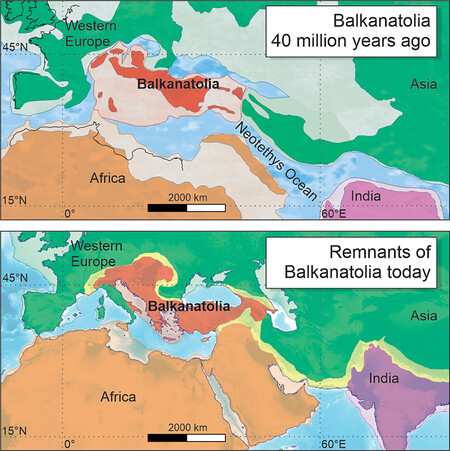34 million years ago a catastrophe shook Europe: there was a massive extinction of the animals that inhabited the continent. This event is known as Grande Coupe, or the Great Bankruptcy, and one of the explanations that scientists have so far taken into account the sudden change in temperatures and the pressure exerted by Asian species on native species. theories that reinforce latest discovery of the lost land area Under the waters of the Aegean Sea and the Adriatic Sea which connected the Balkan Peninsula with Anatolia and would have facilitated the passage from Asia to Europe.
This continent, baptized as the Balkans, precisely because it joined the two peninsulas, would have appeared and sank alternately throughout the Eocene period, which ranges from 56 to 34 million years ago, Intermittently form a large island or archipelago.
At the end of the Eocene, the sudden drop in temperature could have caused decreases in sea level and glaciers.Or become a bridge between Asia and Europe for a long period of time. This would facilitate the passage of all kinds of Asian species to the south of the Old Continent, from rhinos to hamsters, the researchers said.
The authors of the research, a team of French, American and Turkish geologists and paleontologists, raised this hypothesis after making new discoveries of fossils in Turkey, between 38 and 35 million years ago, belonging to a mammal that had Clear Asian morphologyThe first remains of these properties have been found in the area so far.
After this discovery, they reviewed the fossil discoveries made since the nineteenth century on the shores of the Aegean and Adriatic Seas, and found that the regions of Anatolia and the Balkans harbored homogeneous terrestrial animals during most of the Eocene, and differed from the rest of Europe and East Asia, which led them to The theory of a large discontinuous island of Balkantolia provokesAccording to the French National Center for Scientific Research.

Balkantolia Map | National Center for Scientific Research in France.
In that review, the study authors also found that previous research had documented discoveries of mammal remains showing affinities with Asian species in areas of Italy or the Balkans. Up to 10 million years before the occurrence of the Grand Coupe.
All of this led them to conclude that the Balkans were an isolated island or group of islands during much of the Eocene, with different indigenous fauna than those of Europe and Asia. Towards the end of that geological epoch, the cooling of the planet caused the water to drop and in some places freeze, resulting in He would have allowed Asian species to reach Balkantolia firstAs evidenced by fossil remains that were found in Turkey, the Balkans, Italy, and then, when temperatures dropped even more, to the rest of Europe, the beginning of the Grand Coupe.
picture | Christian Palmer

“Beeraholic. Friend of animals everywhere. Evil web scholar. Zombie maven.”
